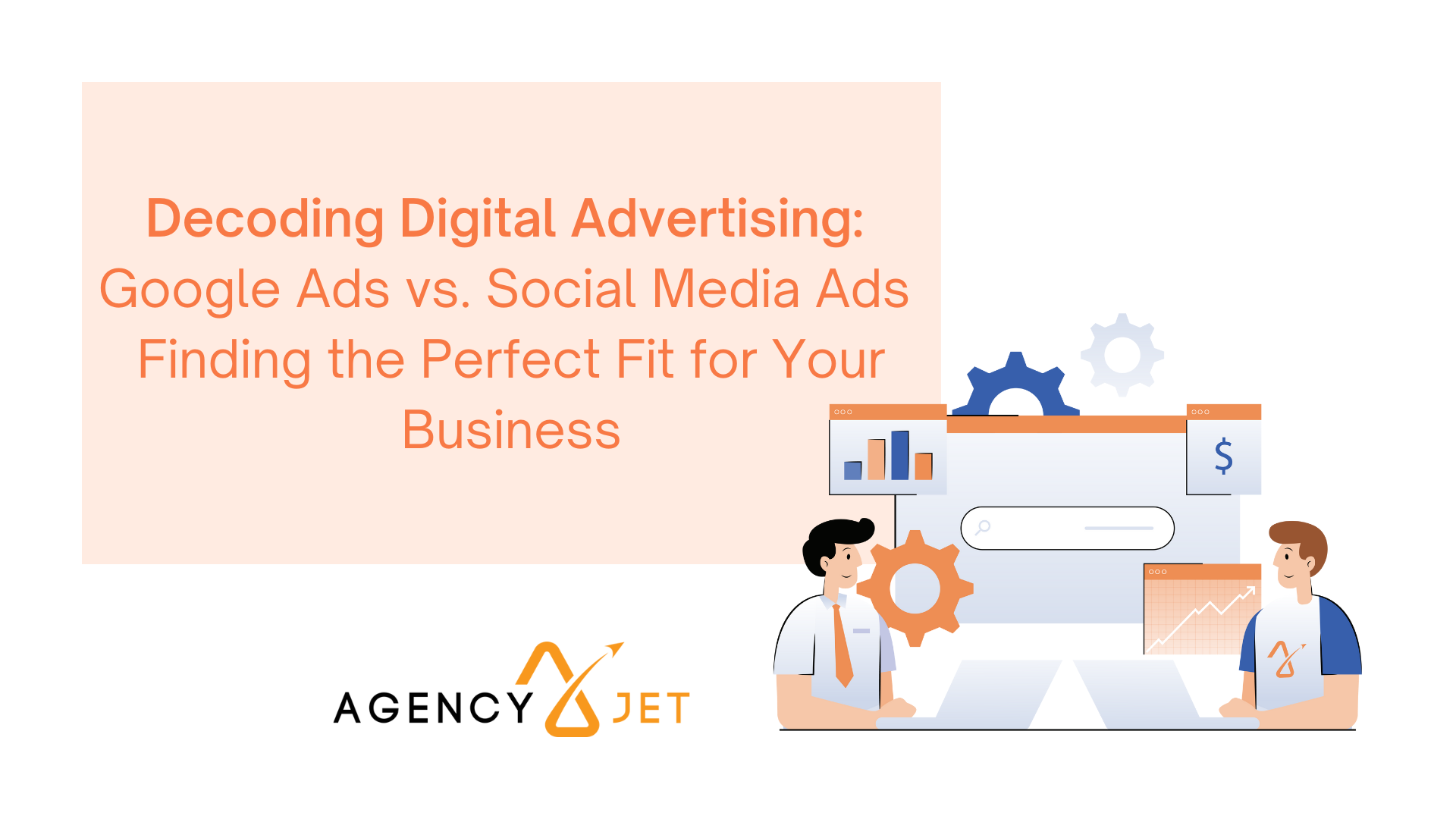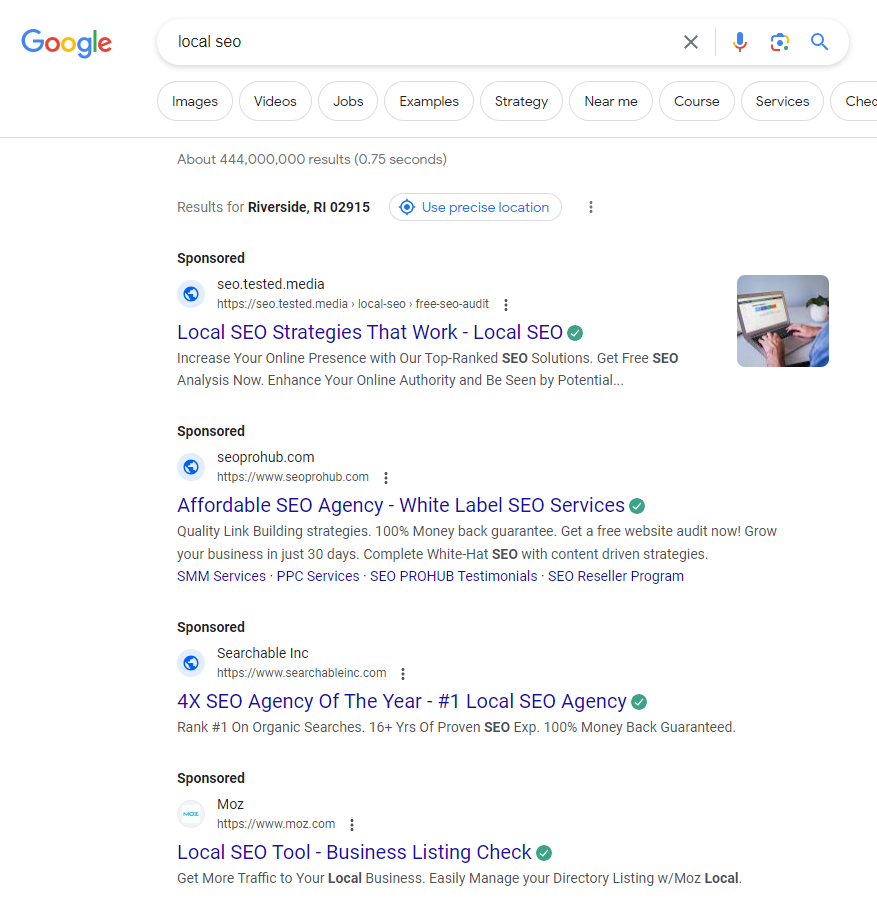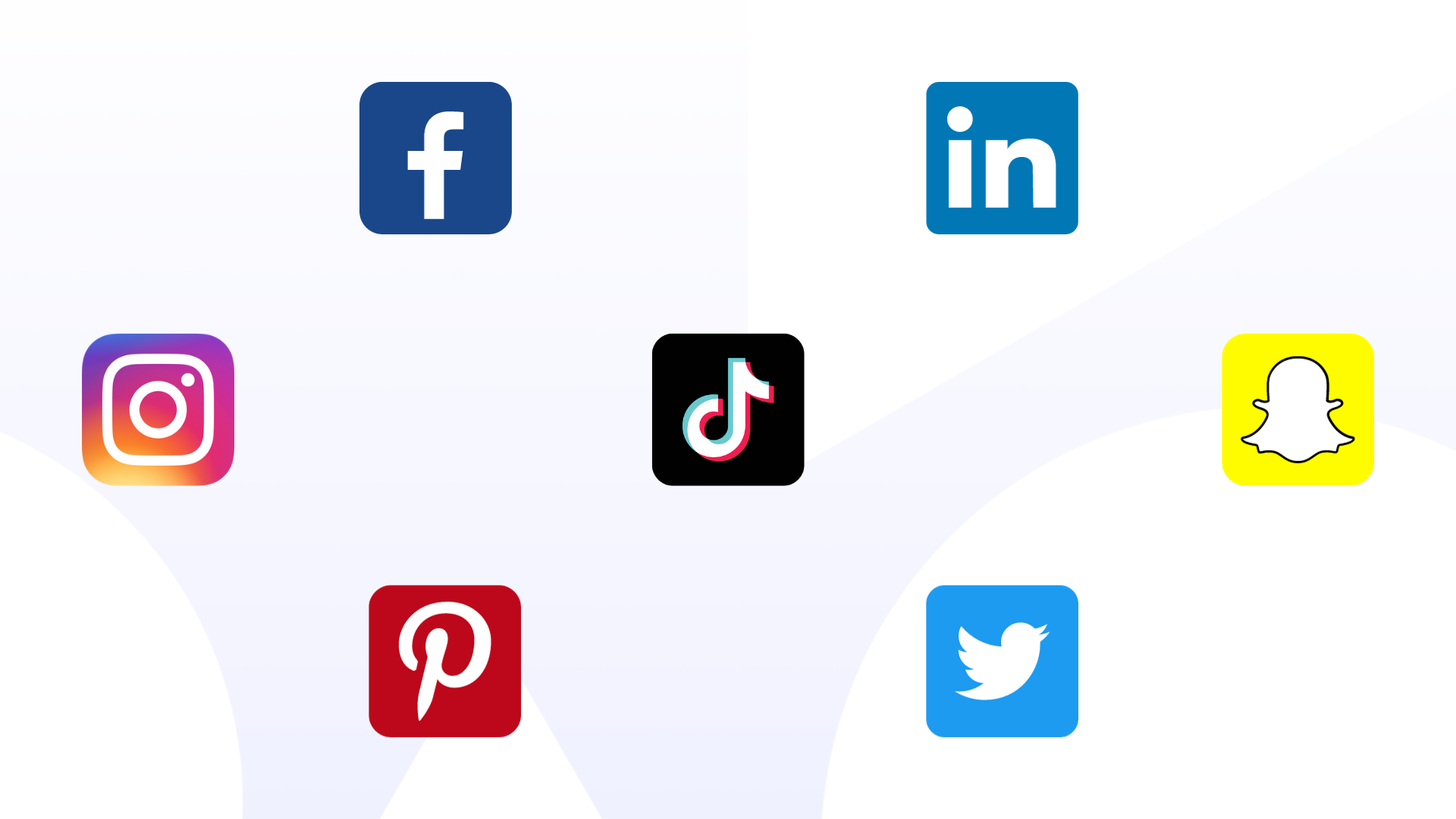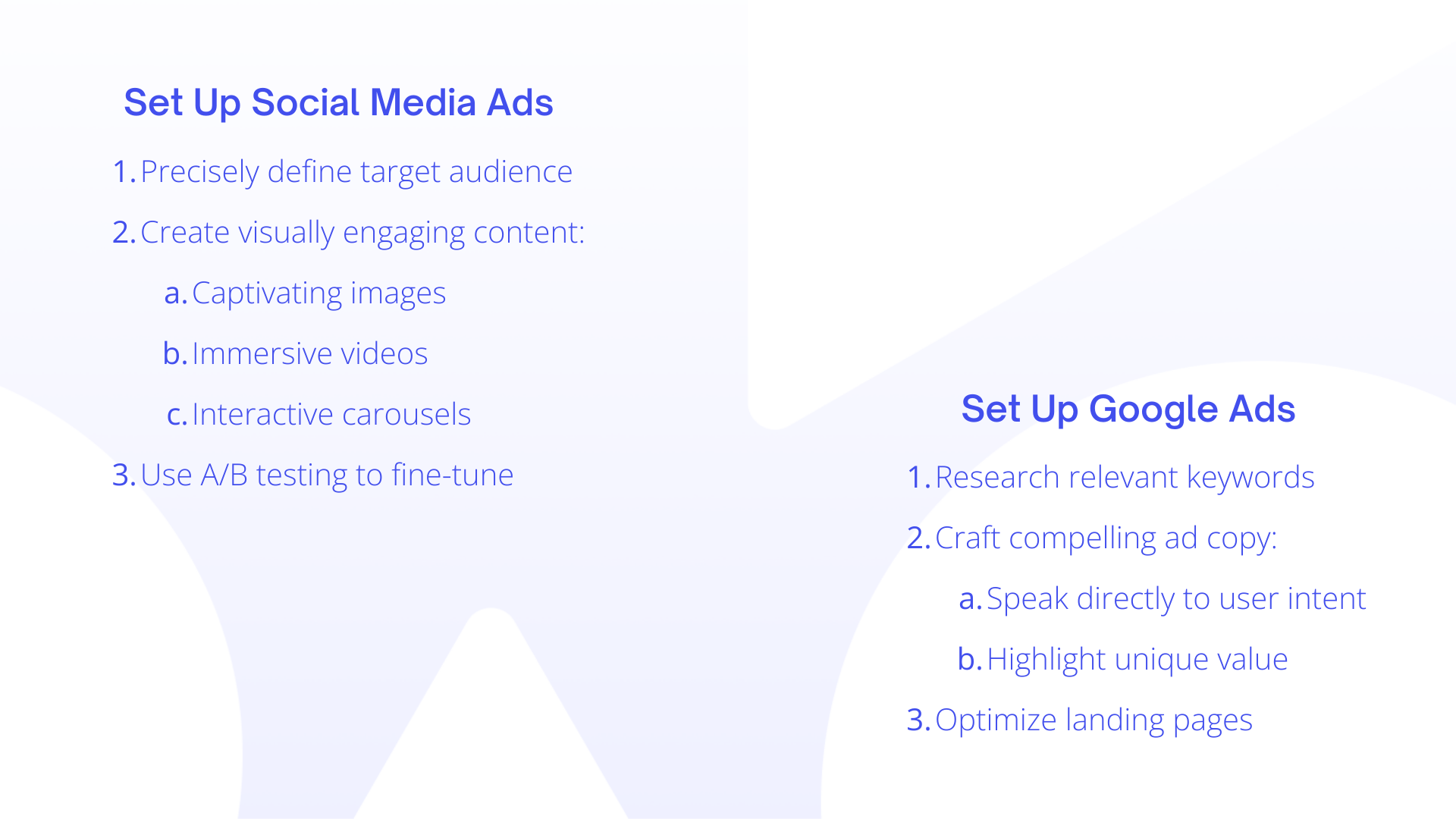Decoding Digital Advertising: Google Ads vs. Social Media Ads – Finding the Perfect Fit for Your Business

In today’s fast-paced digital landscape, the choices available to small business owners for advertising their products or services seem endless.
Among the many options, two giants stand out: Google Ads and social media ads. Choosing between these two can be daunting, like navigating a labyrinth with potential treasures and pitfalls at every turn. The stakes are high, and making the right choice can significantly impact your business’s success and return on investment (ROI).
Imagine this scenario: You are a small business owner eager to expand your online presence and attract more customers. You have a limited budget and want to ensure every penny you spend on advertising counts. The question on your mind is whether to invest in Google Ads vs. social media ads. This dilemma is not unique; it’s one faced by countless entrepreneurs and marketers aiming to harness the power of digital advertising effectively.
This comprehensive guide will demystify the world of digital advertising and help you make an informed decision. We’ll explore the characteristics, strengths, and weaknesses of both Google Ads and social media ads. By the end of this article, you’ll have a clear understanding of which platform aligns best with your business objectives and target audience.
Understanding the Options: Google Ads and Social Media Ads Unveiled
Before we dive into the intricacies of these advertising giants, let’s establish a fundamental understanding of what Google Ads and social media ads entail.
Google Ads: The Search Engine’s Powerhouse

Think of Google Ads as the engine that propels the global information superhighway. Formerly known as Google AdWords, it is Google’s dedicated advertising platform, granting businesses the power to prominently display their advertisements on search engine results pages (SERPs) and across a vast network of partner websites. The significance of Google Ads becomes evident in its core features:
- Keyword targeting: At the heart of Google Ads lies the power of keywords. Advertisers bid on specific keywords relevant to their business, ensuring that their ads are displayed when users initiate searches that include those keywords. This approach allows you to connect with individuals actively seeking products or services that align with your offerings.
- Ad formats: Versatility is a defining characteristic of Google Ads. It offers an extensive array of ad formats to suit various campaign goals. These formats include text ads that appear alongside search results, display ads that grace websites and apps, video ads that captivate on YouTube, and app install ads designed to boost mobile app downloads.
- Cost model: Google Ads operates on a pay-per-click (PPC) model, a financial arrangement wherein advertisers only pay when users click on their advertisements. This means that you invest your advertising budget with the assurance that you are only paying for actual engagement, making it a cost-efficient and results-oriented platform.
Social Media Ads: The Social Connection

Social media ads are the digital bridges that span the vast social landscape, connecting businesses with their target audiences on platforms like Facebook, Instagram, Twitter, LinkedIn, and many others. These advertising solutions allow organizations to reach their intended demographic based on factors such as age, location, interests, and behavioral patterns. Here’s a closer look at what makes social media ads a formidable force in the digital advertising sphere:
- Audience targeting: Precision is the cornerstone of social media advertising. These platforms provide the tools to hone in on your desired audience with unparalleled accuracy. You can fine-tune your targeting based on criteria such as age, gender, location, interests, online behavior, and more. This level of specificity empowers you to connect with individuals who might not be actively seeking your products or services but are likely to be interested.
- Ad formats: Social media platforms embrace creative diversity, offering a multitude of ad formats that cater to various communication styles and campaign objectives. Whether it’s captivating image ads, immersive video ads, interactive carousel ads, or seamlessly integrated sponsored posts, you can convey your message in a visually engaging and contextually relevant manner.
- Cost model: Social media advertising employs a mix of pricing models, including cost-per-click (CPC), cost-per-impression (CPM), and cost-per-engagement (CPE). These models grant you flexibility in choosing how you want to pay for your advertising, allowing you to align your budget allocation with your campaign goals.
Comparative Analysis: Google Ads vs. Social Media Ads
Now that we’ve introduced Google Ads vs. Facebook ads as the heavyweight contenders in digital advertising, let’s embark on a more in-depth comparative analysis. Delving into the distinctions between these advertising giants in terms of targeting options, ad formats, cost considerations, and user behavior is crucial to making an informed decision regarding which platform suits your business goals.
Targeting Options
Google Ads
Google Ads stands as a stalwart in the realm of intent-based targeting. It thrives on the principle of reaching users who are actively searching for products or services closely related to your business. At the core of this targeting mechanism are keywords — the bedrock upon which your advertising strategy is built. Your ads materialize when users’ search queries align with the keywords you’ve strategically chosen.
Social Media Ads
Conversely, social media platforms excel in demographic and interest-based targeting. These platforms provide advertisers with extensive tools to meticulously define their target audience. Beyond mere demographics like age and gender, you can laser-focus your campaigns based on location, interests, behaviors, and even the pages users have engaged with. This approach opens doors to reaching potential customers who might not be actively searching for your products or services but exhibit a pronounced interest in them.
What the Statistics Say
Social media presents an effective approach for retargeting potential customers, with a remarkable 20% higher conversion rate compared to search engine advertising. Another notable advantage of social media advertising is its independence from specific search terms. This means that your target audience encounters your ads without the necessity of initiating searches, enhancing your visibility and reach.
Ad Formats
Google Ads
One of Google Ads’ standout features is its impressive variety of ad formats, each tailored to different marketing objectives. Whether you aim to capture attention with concise text ads, showcase your brand through visually appealing display ads, tell your story through engaging video ads, or boost app downloads with app install ads, Google Ads provides a toolkit to match your campaign’s unique goals.
Social Media Ads
Social media platforms, on the other hand, offer creative flexibility that knows no bounds. You can select from an extensive palette of ad formats, each designed to seize the attention of a diverse and engaged audience. These formats encompass compelling image ads, captivating video ads, interactive carousel ads that allow users to swipe through multiple images, and seamlessly integrated sponsored posts within users’ social feeds.
What the Statistics Say
According to HubSpot, video is the most favored content type in social media advertising, with 50% of marketers opting for this format. This underscores the immersive and engaging nature of video content on social platforms.
Cost Considerations

Google Ads
Google Ads operates under the banner of the pay-per-click (PPC) model. In this scheme, advertisers only incur costs when a user takes the action they desire — clicking on your ad. The cost per click (CPC) varies based on factors like keyword competitiveness and the quality score of your ads. While Google Ads can be remarkably cost-effective, highly competitive keywords can drive up the CPC, necessitating a well-thought-out strategy.
Social Media Ads
Social media advertising brings a blend of pricing models to the table, including cost-per-click (CPC), cost-per-impression (CPM), and cost-per-engagement (CPE). The choice of model often depends on the specific platform, your campaign objectives, and the audience you intend to reach. This diversity in pricing models grants you the flexibility to align your budget allocation with the goals of your campaigns.
What the Statistics Say
As per WordStream, the average CPC across all industries on Google Ads stands at $2.69, underlining its potential cost-effectiveness. In contrast, the average cost-per-thousand impressions (CPM) on Facebook is reported to be $7.19, demonstrating that advertising on social media can also be an effective investment.
User Behavior
Google Ads
The users of Google are predominantly in “search mode.” They actively seek information, solutions, and answers to their queries. This user behavior makes Google Ads exceptionally well-suited for capturing high-intent leads who are closer to making a purchasing decision. However, it’s important to note that the competition for top ad positions can be fierce, necessitating strategic bid management.
Social Media Ads
Social media users inhabit a more leisurely and exploratory mindset. They scroll through their feeds to connect with friends, discover content, and engage with brands they follow. Social media advertising disrupts this exploratory experience by injecting visually appealing and contextually relevant content into users’ feeds, thus capturing their attention and interest.
What the Statistics Say
According to Statista, social media usage worldwide is projected to reach almost 6 billion users in 2027. This immense user base underscores the vast potential reach and engagement available through social media advertising.
Scenario-Based Recommendations
Understanding the nuances of Google Ads and social media ads is crucial, but what really matters is how these platforms align with your specific business goals and situations. Let’s explore some scenarios to guide you toward making the right choice for your advertising needs.
Google Ads

- Search intent marketing: Google Ads capitalizes on users actively searching for products or services, making it highly effective for businesses that offer specific solutions. For instance, consider a plumbing company. When a user searches for “emergency plumber near me,” a well-crafted Google Ad can lead to direct inquiries. A case study by WordStream reveals that advertisers, on average, make $2 in revenue for every $1 spent on Google Ads.
- E-commerce: Google Shopping Ads allow online retailers to promote their product listings in Google’s search results. These eye-catching ads feature images of products alongside prices and names of stores, making it simpler for consumers to make purchases. Shopping Ads are responsible for a substantial 85.3% of all clicks when considering both AdWords and Google Shopping campaigns collectively.
- Local businesses: Google Ads is an excellent tool for local businesses looking to attract nearby customers and build their local SEO. Restaurants, in particular, can promote special offers, menus, and location details. According to statistics, 72% of consumers conducting a local search will visit a store within a five-mile radius of their location. Utilizing local Google Ad campaigns is an effective method to connect with potential customers near your establishment.
Social Media Ads
- Brand awareness and engagement: Social media platforms like Facebook and Instagram are perfect for building brand awareness and fostering engagement with a broad audience. Coca-Cola’s “Share a Coke” campaign is a prime example, where users were encouraged to share photos of Coke bottles personalized with their names. This campaign generated over 500,000 user-generated images shared on social media, amplifying brand visibility.
- Targeting specific demographics: Social media ads offer granular targeting options based on demographics, interests, and behaviors. This capability is particularly valuable for businesses with well-defined target audiences. For instance, a luxury beauty brand can precisely target women aged 25-45 interested in skincare and cosmetics on Facebook and Instagram, leading to more relevant ad impressions and higher conversion rates.
- Retargeting: Social media platforms excel at retargeting users who have previously engaged with a brand’s website or content. For instance, a fashion retailer can use Facebook Ads to display products that users viewed but didn’t purchase. According to Skai, retargeting can boost engagement rates, sometimes up to 400%.
- Influencer marketing: Collaborating with influencers on platforms like Instagram and YouTube can be a highly effective social media advertising strategy. Brands like Daniel Wellington leveraged influencer marketing campaigns to achieve exponential growth. By partnering with fashion influencers, they gained massive exposure, credibility, and trust among their target audience.

FAQs: Answering Your Burning Questions
As you navigate the intricate landscape of digital advertising, you’re likely to encounter many questions. Here, we address some of the most frequently asked ones to provide clarity and guidance on your journey.
How Should I Allocate My Budget Between Google Ads and Social Media Ads?
Answer: Budget allocation should be a strategic decision influenced by your specific goals and target audience. If your primary objective is to drive immediate conversions and capture high-intent leads, consider allocating a significant portion of your budget to Google Ads.
This platform excels at connecting you with users actively searching for products or services related to your business. On the other hand, if you seek to build brand awareness, foster engagement, or target a specific audience based on demographics and interests, you may want to lean towards social media ads.
An effective strategy can also involve a balanced allocation that leverages the strengths of both platforms, achieving a harmonious blend of immediate conversions and brand-building endeavors.
How Do I Set Up Effective Campaigns?

Answer: The effectiveness of your digital advertising campaigns hinges on meticulous planning and execution.
For Google Ads:
- Conduct comprehensive keyword research to identify the terms and phrases most relevant to your business.
- Craft compelling ad copy that speaks directly to user intent, highlighting your products or services’ unique value.
- Pay close attention to landing page optimization, ensuring that the page users land on is aligned with their expectations and encourages conversions.
For Social Media Ads:
- Start by precisely defining your target audience, taking advantage of the platform’s robust audience targeting options.
- Create visually engaging content that resonates with your audience, whether it’s captivating images, immersive videos, or interactive carousel ads.
- Implement A/B testing to fine-tune your campaigns over time, allowing data-driven insights to guide your creative and strategic decisions.
How Can I Track ROI?
Answer: Tracking return on investment (ROI) is paramount to evaluating the success of your digital advertising efforts.
For Google Ads:
- Utilize Google Analytics to gain deep insights into the performance of your Google Ads campaigns.
- Monitor conversions, click-through rates (CTR), and return on ad spend (ROAS) to assess your campaigns’ effectiveness in driving revenue and engagement.
For Social Media Ads:
- Leverage the platform-specific analytics tools provided by the social media platforms where you run your ads.
- Keep a keen eye on conversions, click-through rates, and engagement metrics to gauge the impact of your social media advertising efforts.
- A lookalike audience is a powerful tool used by marketers to reach more potential customers. It involves using data collected from existing customers to identify and target new audiences with similar characteristics. By identifying attributes that are likely to lead to successful campaigns, marketers can create lookalike audiences that are tailored to their specific needs.
The first step in creating a lookalike audience is to collect data
Can I Use Both Platforms Together?
Answer: Absolutely! Many businesses find great success in adopting a multi-channel approach that leverages both Google Ads and social media ads in tandem.
- Use Google Ads to capture high-intent search traffic, ensuring your products or services are visible to users actively seeking them out.
- Simultaneously, employ Social Media Ads to build brand recognition, foster engagement, and reach a broader audience that might not be actively searching for your offerings.
- The synergy of using both platforms can yield remarkable results, allowing you to cover various stages of the customer journey and maximize your digital advertising endeavors.
The Bottom Line: Navigating the Digital Advertising Landscape

In the ever-evolving world of digital advertising, choosing the right platform for your business is paramount. Google Ads vs. Instagram ads each have their strengths and can significantly contribute to your success when utilized strategically.
To recap:
- Use Google Ads for high-intent searches and immediate conversions.
- Employ social media ads for brand awareness, engagement, and precise audience targeting.
- Consider a balanced approach when your budget allows.
Remember, the key to success lies in understanding your goals, your audience, and the strengths of each platform. It’s not about choosing one over the other but finding the perfect fit for your unique business needs.
As you embark on your digital advertising journey, don’t hesitate to explore further. Request a free website assessment at Agency Jet to fine-tune your advertising strategy and maximize your ROI. Your digital advertising treasure awaits — navigate wisely and prosper in the digital age!
